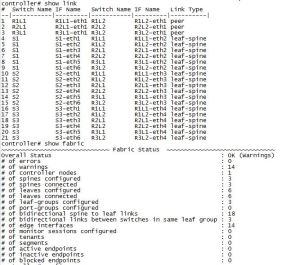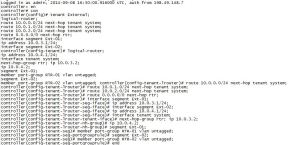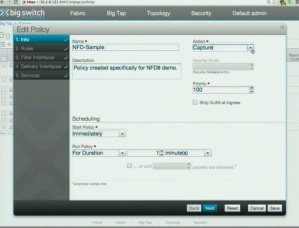I will readily admit that the use of SDN as a buzzword makes me want to drive into oncoming traffic. Having endured so much SDN hype, I’m practically giddy when I get to see SDN fleshed out with actual real-life-you-can-touch-it’s-not-just-vaporware products.
Big Switch’s Networking Field Day 8’s presentations focused on showing off Big Cloud Fabric as being practical, usable, and even better, here today – well, shipping at the end of the month, but you get the idea. I loved that not only did Big Switch give all the delegates access to an invite-only beta lab, but that the lab totally rocked for getting to know the product and for laying hands on the technology that would be presented.*
Now, onto the Big basic ideas of Big Cloud Fabric (pun intended of course): the main components include white box switches running Switch Light OS code, controllers speaking OpenFlow** with proprietary extensions down to these switches, and a REST API that sits at the heart of where the magic the happens.
Big Switch Cloud Fabric has purposely narrowed its focus to data center implementations, more specifically a pod design that scales up to 16 racks. Each server connects to each of two TOR leaf switches and those leaves in turn connect to each of the spine switches, with up to 6 spines. These spine switches can be connected to upstream services like firewalls, load balancers, and IPS devices. A primary and a backup controller run the show and all the switches, preloaded with ONIE as a bootstrap image, reach out and get their OS from the controller, much like the concept of PXE boot.
You should also be aware of the Big Switch concepts of Logical Segments, think VLANs for tenants, and Logical Routers, think layer 3 routing within the same tenant. The concept of a System Router allows for tenant to tenant communication, but otherwise, tenant A talks to tenant A’s stuff, and tenant B talks to tenant B’s stuff.
Okay, now for the “you had my curiosity. But now you have my attention” part – what does it look like, how do I make it work? What cool features do I get with this?
Well, Rob Sherwood, CTO, classifies the world into three types of engineers, and Big Switch tailored the product to address each:
The “I am a network admin, you can take my CLI when you pry it from my cold dead hands.”
The “I have been working with vCenter most my life, I don’t understand this CLI stuff, just give me a GUI to make this work.”
The “If there is not an API, then I don’t want to care, I’m from the DevOps end of the world.”
I tend to fall into category one, so I really enjoyed working the beta lab from the CLI. Here’s a couple of screen shots of what common tasks look like – notice nothing too scary or outlandish, pretty human understandable. If that human happens to be a network engineer.


Big Switch clearly spent some time on GUI design as well, below are examples of common tasks from that angle. I also recommend watching this video to get a good idea of product features and layout – as a bonus you even get to see how the product helps Rob troubleshoot while he’s doing the demo.


Lastly, also in the words of Rob Sherwood, “the REST API is treated as a first class citizen” so whatever automation you want to start playing with that leverages the API shouldn’t make you feel like it was a bolt on afterthought.
Below are some cool features of Big Cloud Fabric design that are worth mentioning, some I’ve already alluded to:
- hitless upgrades – you lose capacity during upgrades, but not connectivity, and we’re talking minutes not hours.
- zero touch switch configuration – no logging in box per box; the GUI will even tell you if you cabled something wrong
- control and data plane separation – packets keep moving when controllers go down, but note that new switches to the fabric are out of luck when all controllers are down, there is no default forwarding behavior
- service chaining to multiple devices – you can send packets out to multiple devices, like a cluster of firewalls or load balancers, and when they come back the controller recognizes that fact and sends them where they need to go next.
- test path feature- track down the exact logical and physical path packets are taking and what policies they hit
- OpenStack – plugin integration with OpenStack Neutron
So that’s Big Cloud Fabric in a nutshell. A software defined delicious nutshell. That you could actually eat.
*Never underestimate the power of giving engineers the ability to run your product in a lab scenario, nothing helps engineers “get it” better than doing the configuration themselves and seeing the product in action. The effort Big Switch put into the beta lab demo clearly showed, kuddos to them.
**Big Switch spends a good amount of time in their presentations helping people get comfortable with the notion of OpenFlow and their particular architecture, including using comparisons to traditional supervisor/line card models, references to terms like VRFs/VLANs that relate to traditional networking, and debunking some common OpenFlow myths. Definitely worth watching the suite of recorded videos here for more details.
Disclaimer: While Networking Field Day, which is sponsored by the companies that present, was very generous to invite me to this fantastic event and I am very grateful for it, my opinions are totally my own, as all redheads are far too stubborn to have it any other way.
Published 9/29/2014




